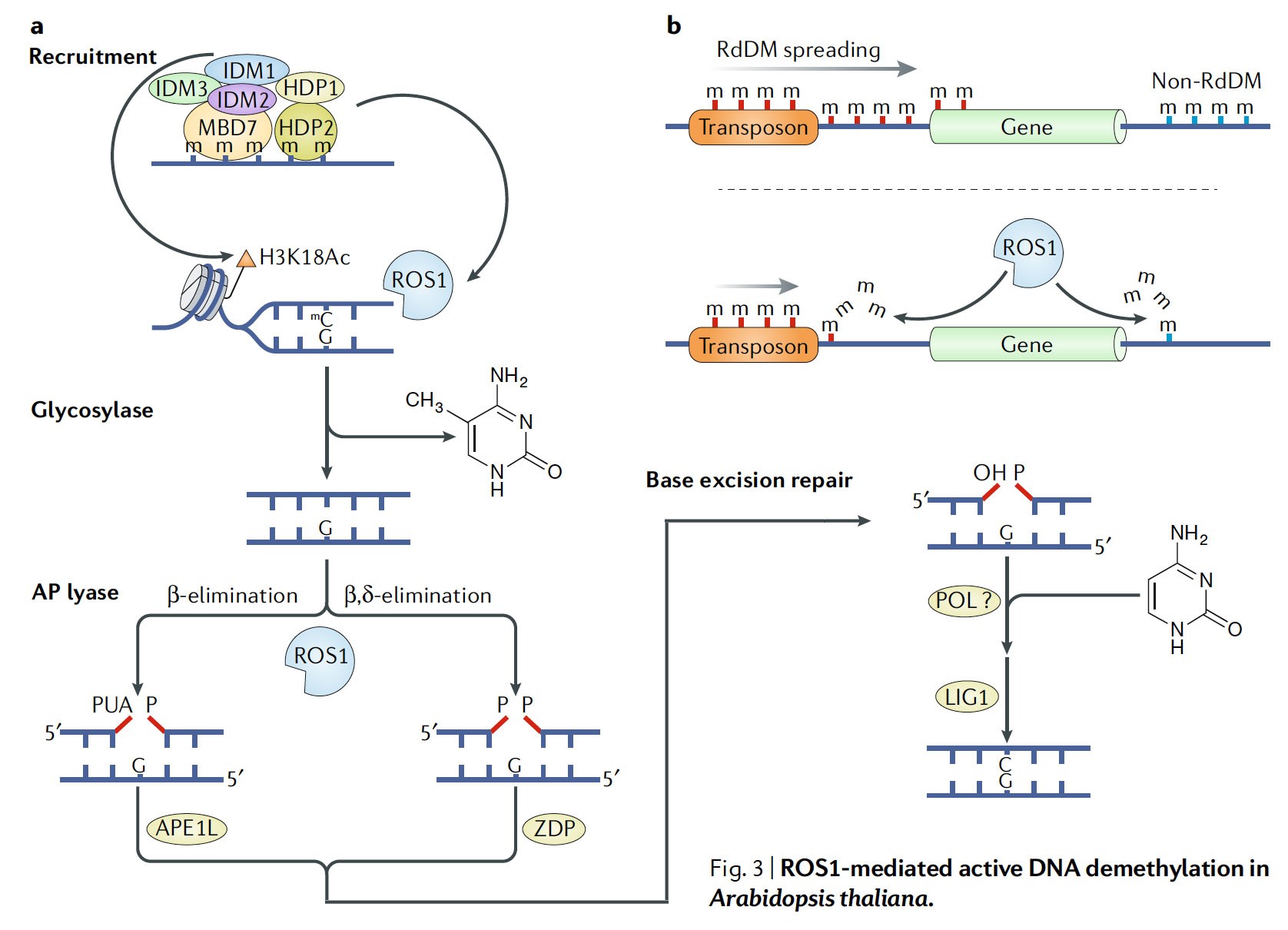博文
连载:大牛朱健康最新植物DNA甲基化综述(4)
||
2018年5月21日,Nature Reviews Molecular Cell Biology在线发表了中国科学院上海植物逆境生物学研究中心朱健康研究员、张惠明研究员与郎曌博研究员共同完成的题为“Dynamics and function of DNA methylation in plants”的综述文章。本博客将持续解读该文章,本文为连载第四期,包括第一章节DNA甲基化动态的第三部分内容:主动DNA去甲基化。
Dynamics and function of DNA methylation in plants
First author: Huiming Zhang; Affiliations: Shanghai Center for Plant Stress Biology, Chinese Academy of Sciences (中国科学院上海植物逆境生物学研究中心): Shanghai, China
Corresponding author: Jian- Kang Zhu
Active DNA demethylation
Lack of DNA methyltransferase activity or shortage of a methyl donor following DNA replication results in failure to maintain methylation, which is known as passive DNA demethylation76-79. DNA methylation can also be erased enzymatically, which is referred to as active DNA demethylation. In contrast to the DNA methylation reaction, which is catalysed by a single DNA methyltransferase enzyme, active DNA demethylation requires a team of enzymes, with the enzyme initiating the process referred to as a DNA demethylase. In plants, a family of bifunctional 5-mC DNA glycosylases-apurinic/apyrimidinic lyases initiates active DNA demethylation through abase excision repair pathway80-82 (Fig. 3a). Active DNA demethylation in mammals also involves a DNA glycosylase and thus base excision repair. However, the plant DNA glycosylases can recognize and directly remove the 5-mC base, whereas in mammals, the 5-mC must be oxidized before the DNA glycosylase can catalyse base removal8,83.
缺少甲基化转移酶活性或者DNA复制后缺少甲基供体会导致未能持续维持甲基化,也就是所谓的被动DNA去甲基化。DNA甲基化也可以通过酶的方式来擦除,也就是主动DNA去甲基化。与DNA甲基化反应受到单个DNA甲基化转移酶所催化相反,主动DNA去甲基化需要一系列的酶来实现,而起始这个过程的酶就叫做DNA去甲基化酶。在植物中,一类具有双功能的5-mC DNA糖基化酶-脱嘌呤/脱嘧啶裂解酶家族通过碱基切除修复途径来起始主动DNA去甲基化(图3a)。哺乳动物中的主动DNA去甲基化也涉及到一个DNA糖基化酶,同时也有剪辑切除修复机制参与其中。然而,植物DNA糖基化酶可以识别并直接移除5-mC碱基,而在哺乳动物中,5-mC必须先经过氧化,然后才能被DNA糖基化酶所催化、移除。
A. thaliana has a family of four bifunctional 5-mC DNA glycosylases, including REPRESSOR OF SILENCING 1 (ROS1), TRANSCRIPTIONAL ACTIVATOR DEMETER (DME), DEMETER-LIKE PROTEIN 2 (DML2) and DML380,82, which can excise 5-mC from all cytosine sequence contexts81,84-87. ROS1, DML2 and DML3 are expressed in all vegetative tissues, whereas DME is preferentially expressed in companion cells (伴随细胞) of the female and male gametes, that is, in the central cell of the female gametophyte and in the vegetative cell of the male gametophyte86,88.
拟南芥双功能5-mC糖基化酶基因家族有4个基因,分别是沉默抑制子ROS1、转录激活子DME、类DME蛋白DML2以及DML3,这些酶能够识别所有序列类型的胞嘧啶并切除5-mC。ROS1、DML2和DML3在所有的营养器官中均有表达,而DME优先在雌雄配子的伴细胞中表达,也就是雌配子体的中央细胞和雄配子体的营养细胞。
During DNA demethylation, these bifunctional enzymes act first as DNA glycosylases to hydrolyse the glycosylic bond between the base and the deoxyribose and then as apurinic or apyrimidinic lyases to cut the DNA backbone and produce an abasic site (Fig. 3a). The excision of the 5-mC base is followed by β-eliminationor β,δ-elimination reactions, which result in a gap that terminates with a 3ʹ-phosphor-α,β-unsaturated aldehyde or with a 3ʹ phosphate, respectively. Subsequently, the apurinic/apyrimidinic endonuclease DNA-(APURINIC OR APYRIMIDINIC SITE) LYASE (APE1L) and the DNA phosphatase POLYNUCLEOTIDE 3′-PHOSPHATASE ZDP function downstream of the β-elimination and β,δ-elimination reactions, respectively, to generate a 3ʹ OH group so the gap can be filled by DNA polymerase and ligase enzymes89-91 (Fig. 3a). A. thaliana DNA LIGASE 1 (LIG1) is probably the ligase in the active DNA demethylation pathway, as indicated by its subcellular colocalization with ROS1, ZDP and APE1L, and by the observation that LIG1 is essential for demethylation and activation of the maternally imprinted genes FLOWERING WAGENINGEN and MEA (MEDEA) in the endosperm92,93.
在DNA去甲基化过程中,这些双功能酶起先作为DNA糖基化酶水解碱基和脱氧核糖之间的糖基键,然后作为脱嘌呤或脱嘧啶裂解酶去切段DNA链,产生一个无碱基位点(图3a)。5-mC碱基的切除跟随着β-消除或β,δ-消除反应,会形成一个以3-磷-α,β-不饱和醛或3磷酸为结尾的缺口。随后,脱嘌呤/脱嘧啶核酸内切酶DNA-(无嘌呤或无嘧啶位点)裂解酶APE1L和DNA磷酸酶多聚核苷酸3ʹ-磷酸酶ZDP在β-消除或β,δ-消除反应的下游发挥作用以生成一个3ʹ OH基团,进而缺口能够被DNA聚合酶和连接酶所填充(图3a)。拟南芥DNA连接酶LIG1的亚细胞共定位与ROS1、ZDP和APE1L一致,且对于胚乳组织中母本印迹基因FWA和MEA的去甲基化和激活是必需的,这些证据显示LIG1可能是主动DNA去甲基化通路中发挥作用的连接酶。
ROS1 was shown in vitro to randomly slide at a specific target site94, but in cells on a global scale, DNA demethylases exhibit target specificity, which depends on distinct chromatin characteristics and on recruiting proteins. Demethylation by DME favours small, AT-rich transposons in euchromatic regions, leading to altered expression of nearby genes88,95-97. ROS1 also targets transposons, which tend to be near genes98. This suggests that ROS1-mediated demethylation helps to establish boundaries between transposons and genes and to prevent the spreading of DNA methylation and transcriptional silencing from transposons98. ROS1 is particularly important for counteracting DNA methylation established by the RdDM pathway, although it also demethylates RdDM-independent regions18,19,80,98 (Fig. 3b). It remains unclear whether small RNAs, which determine target specificity in RdDM, also mediate the targeting of ROS1 to certain loci, even though the RNA-binding protein ROS3 is important for demethylation at several ROS1-dependent genomic regions99. ROS1 targeted transposons and other genomic regions are characterized by enrichment of acetylated H3K18 and of H3K27me3 and depletion of H3K27me and H3K9me298. At a subset of ROS1 target loci, a chromatin environment that is permissible for active demethylation is established by INCREASED DNA METHYLATION 1 (IDM1), which is a histone acetyltransferase that binds methylated DNA and acetylates histone H3 at chromatin sites lacking H3K4me2 andH3K4me3100, that is, sites not yet associated with active transcription.
ROS1在体外能够在特异性的靶位点上随机滑动,但在细胞内,DNA去甲基化酶存在靶标特异性,主要取决于不同的染色质特性和招募的蛋白。由DME介导的去甲基化则偏爱常染色质区域小的、富含AT的转座子,继而导致邻近基因表达量的改变。ROS1同样靶向转座子,进而倾向于在基因附近。这说明由ROS1介导的去甲基化有助于在转座子和基因之间建立边界,预防来自转座子的DNA甲基化和转录沉默扩散。ROS1也部分作用于抵消由RdDM通路建立的DNA甲基化,尽管ROS1也去甲基化非RdDM依赖性的区域(图3b)。对于RdDM中控制靶位点特异性的小RNA是否在ROS1靶向特定位点的过程中发挥作用还不清楚,尽管RNA结合蛋白ROS3对于一些ROS1依赖性基因组区域的去甲基化非常重要。ROS1靶向转座子和其他一些富含乙酰化的H3K18和H3K27me3的基因组区域和一些没有H3K27me和H3K9me2的基因组区域。
Targeting ROS1 to some genomic regions is mediated by an anti-silencing protein complex, IDM, which consists of IDM1, IDM2, IDM3, METHYL-CPG-BINDING DOMAIN-CONTAINING PROTEIN 7 (MBD7), HARBINGER TRANSPOSON-DERIVED PROTEIN 1 (HDP1) and HDP2100-103 (Fig. 3a). IDM2 is an α-crystallin domain-containing protein that interacts with IDM1 and is required for IDM1-dependent H3K18 acetylation in planta101. MBD7 preferentially binds to highly methylated, CG-dense regions and physically interacts with IDM2, as well as with the IDM2 paralogue IDM3, which also interacts with IDM1 and is required to prevent gene repression and DNA hypermethylation102,104. Although the IDM complex is proposed to ensure IDM1 targeting to methylated DNA loci, how IDM1-catalysed histone acetylation helps to recruit ROS1 for active DNA demethylation remains undetermined.
ROS1靶向某些基因组区域是由抗沉默蛋白复合物IDM所介导的,该复合物包含IDM1、IDM2、IDM3、MBD7、HDP1和HDP2(图3a)。IDM2是一个含α-晶状体结构域的蛋白,其能够与IDM1发生互作,同时对于植物中IDM1依赖性的H3K18乙酰化是需要的。MBD7优先结合到高度甲基化的CG致密区域,物理上能够与IDM2互作,同时也能够与IDM2的同源物IDM3互作,而IDM3也能够与IDM1发生互作,MBD7作用于防止基因被抑制和DNA超甲基化。尽管IDM复合物被认为能够保证IDM1靶向甲基化的DNA位点,而IDM1催化的组蛋白乙酰化是如何招募ROS1来进行DNA去甲基化的仍然还不是很清楚。
doi: https://doi.org/10.1038/s41580-018-0016-z
Journal: Nature Reviews Molecular Cell Biology
Published date: 21 May, 2018
https://blog.sciencenet.cn/blog-3158122-1150953.html
上一篇:连载:大牛朱健康最新植物DNA甲基化综述(3)
下一篇:Nature Plants:作物中长末端重复序列LTR反转录转座子鉴定方法
全部作者的其他最新博文
- • Plant Physiology:CsMADS3促进柑果中的叶绿素降解和类胡萝卜素合成(华中农业大学)
- • Molecular Plant:LBD11-ROS反馈调节作用于拟南芥的维管形成层增殖和次生生长(浦项科技大学)
- • Science Advances:根结线虫通过调控植物的CLE3-CLV1模块,促进侵染进程(日本熊本大学)
- • Nature Communications:油菜素内酯参与植物营养生长期转变的分子机制解析(浙江农林大学)
- • Current Biology:光合作用产生的蔗糖驱动侧根“生物钟”(德国弗莱堡大学)
- • PNAS:花同源异型基因在叶中被抑制、花中被激活的分子机制(南卡罗来纳大学)

